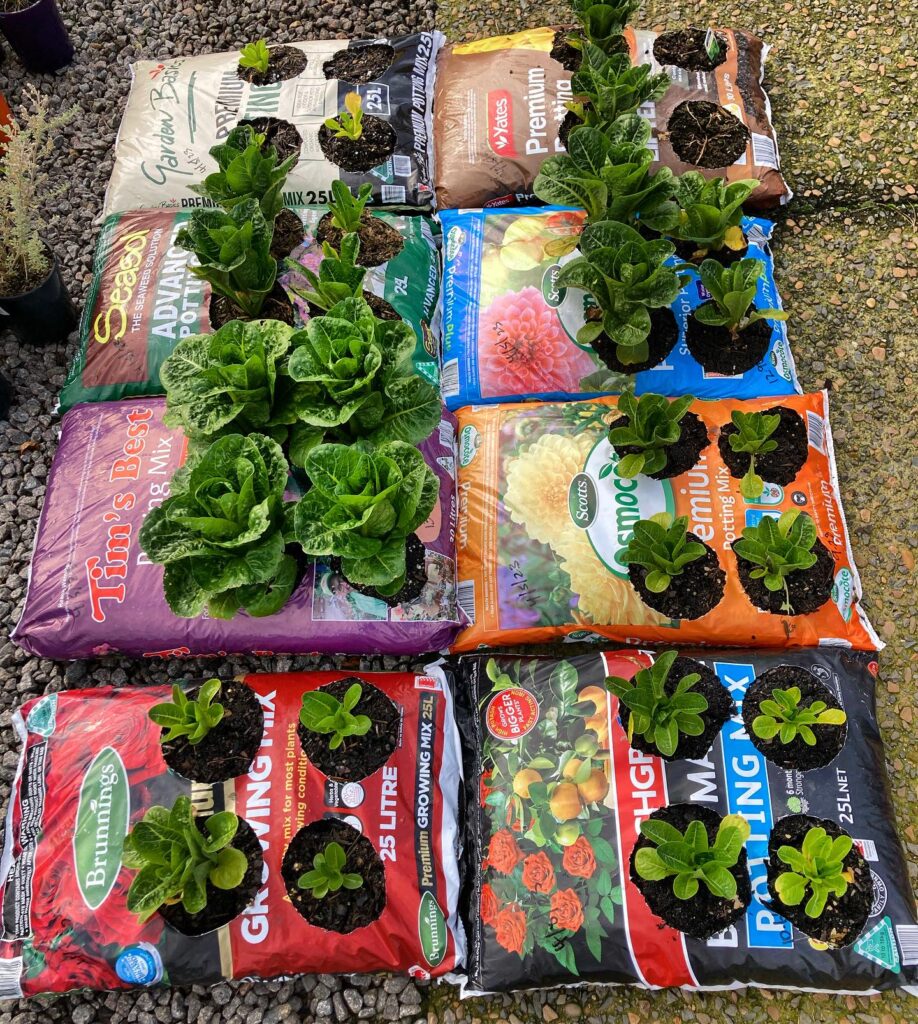We have been growing vegetables in garden beds for about 18-months. We have had mixed success and I have been looking at what might be causing some of our vegetables to not grow very well. Something that I really took for granted was the soil that I used for our raised garden beds. I’m starting to think that this is probably one of the reasons that some of our plants are not growing well.
A place called “Tims Garden Centre Campbelltown, NSW” did us a fantastic service by testing their own potting mix, and comparing it to seven other mixes available here in Australia. On their Facebook Page they documented their results.

The potting mixes are all Australian Standard Premium potting mixes. Of all the mixes, only two of them actually grew the lettuce that they planted. By far the worst was “Garden Basics” from Bunnings, which is unfortunately the brand that I have been using …
Their own potting mix, “Tim’s Best”, grew the best lettuce, but is only available at their location in Campbelltown, NSW. The second best was “Scotts Osmocote Premium Plus Superior Potting Mix“, which is available at Bunnings. The cost is about 2.5 x as much as the Garden Basics that I have previously purchased, but it looks WAY better to actually grow food!
A video of the results from the test can been seen on Tims Garden Centre’s Facebook Page.
Based on those results, the fact that I’m in South Australia, and what I have seen in my own garden beds, I will be buying the Scotts potting mix next time I need to fill or top up a bed.
Out of curiosity I thought I would ask AI what they recommended for soil for filling a raised vegetable garden bed, and this is what it came back with:
If you are planning to start a raised vegetable garden bed, one of the most important decisions you have to make is what kind of soil to use. The soil in your raised bed will affect the health, growth and yield of your plants, so you want to choose the best option for your needs.
There are different types of soil that you can use for your raised bed, depending on your budget, availability and preferences. Here are some of the most common ones:
- Topsoil: This is the upper layer of soil that you can find in your yard or garden. It is usually rich in organic matter and nutrients, but it may also contain weeds, seeds, pests and diseases. You can use topsoil for your raised bed, but you should make sure to remove any unwanted elements and mix it with other materials to improve its drainage and aeration.
- Compost: This is a natural fertilizer that is made from decomposed organic matter, such as kitchen scraps, yard waste, manure and leaves. Compost adds nutrients, moisture and beneficial microorganisms to the soil, and helps improve its structure and water retention. You can use compost alone or mix it with topsoil or other materials for your raised bed.
- Potting mix: This is a commercial product that is designed for container gardening. It is usually made from peat moss, perlite, vermiculite and other ingredients that provide good drainage, aeration and moisture retention. Potting mix is sterile and free of weeds, seeds, pests and diseases, but it may also lack nutrients and organic matter. You can use potting mix for your raised bed, but you should supplement it with compost or fertilizer to enrich it.
- Raised bed mix: This is a special blend of soil that is formulated for raised beds. It usually contains a combination of topsoil, compost, peat moss, perlite and other materials that provide optimal conditions for raised bed gardening. Raised bed mix is convenient and ready to use, but it may also be more expensive and harder to find than other options.
The best soil for your raised bed depends on several factors, such as the type of plants you want to grow, the size and depth of your bed, the climate and weather conditions in your area, and your personal preferences. You may have to experiment with different mixes and ratios until you find the one that works best for you.
Some general tips to follow when choosing and preparing your soil are:
- Use organic materials as much as possible to avoid adding chemicals or contaminants to your soil and plants.
- Add compost or fertilizer regularly to replenish the nutrients in your soil and boost your plant growth.
- Loosen and aerate your soil before planting to improve its drainage and oxygen flow.
- Mulch your soil with straw, wood chips or other materials to conserve moisture, prevent weeds and moderate temperature fluctuations.
- Rotate your crops every year to prevent soil depletion and pest infestation.
With the right soil in your raised bed, you can enjoy a bountiful harvest of fresh and healthy vegetables from your own backyard.